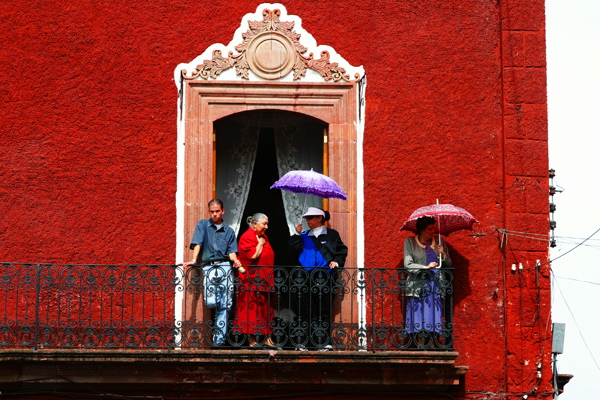San Miguel de Allende is as surrealistic as a Gabriel García Márquez novel, as mystical as an Octavio Paz poem, and as vibrant as a Frida Kahlo painting. During the Colonial period, when thick veins of silver in the nearby hills made the town as rich as the fabled Seven Cities of Cibola, palatial mansions and ornate churches exploded across the hills of Móctezuma, to which the town clings, like Roman candles on a dark night.
The streets may not have been paved in gold, but some of the chapels and vaulted living rooms were certainly gilded in the precious metal. It was the town’s Golden Age. Elaborate carved-wood doors, protecting elegant residences, fronted the Jardín, the town’s communal living room. On Saturday evenings, young men dressed in embroidered shirts and high-waisted jackets wooed beautiful dark-haired women by hiring the mariachi players who waited to be beckoned from beneath the portales, the cool stone arcades on either end of the garden. Ancient women sat next to small carts with kerosene lamps selling roasted corn dusted with cinnamon while Mexican cowboys admired the silver trim on belts and boots being sold in the markets. And everywhere there were children scurrying about, chasing dogs or pigeons or each other.
The thing is, it is still that way, though now the young men are more likely to wear crisp Polo shirts and the women prefer skin-tight black pants instead of the long, gathered skirts and colorful rebozos of their ancestors.
Much of San Miguel, though certainly not all, has been frozen in time. To 1811, to be exact. That is the year the town’s namesake, General Ignacio Allende, was executed before a firing squad and had his head displayed for ten years in a cage on the corner of a nearby granary. During those same ten years, the town was sacked and looted by Spanish soldiers, and a thriving population of 50,000 was reduced to a small cadre of caretakers. As one historian of the town writes, San Miguel became a puebla of “custodians of churches and palaces of colonial splendor lacking both devotees and merchant princes…left to itself, the seasons, and the sun.”
In other words, a hundred years of solitude. In the end, this is what saved San Miguel.
Tags: Mexico, San Miguel de Allende
-
I have always wanted to go there…Would like to hear more honest insight to the place…More pictures please…Want to save up to go there….
Smiles
-
Fred, you HAVE been everywhere I’ve been. And Sonia–lots more great photos coming.
Comments are now closed.


3 comments